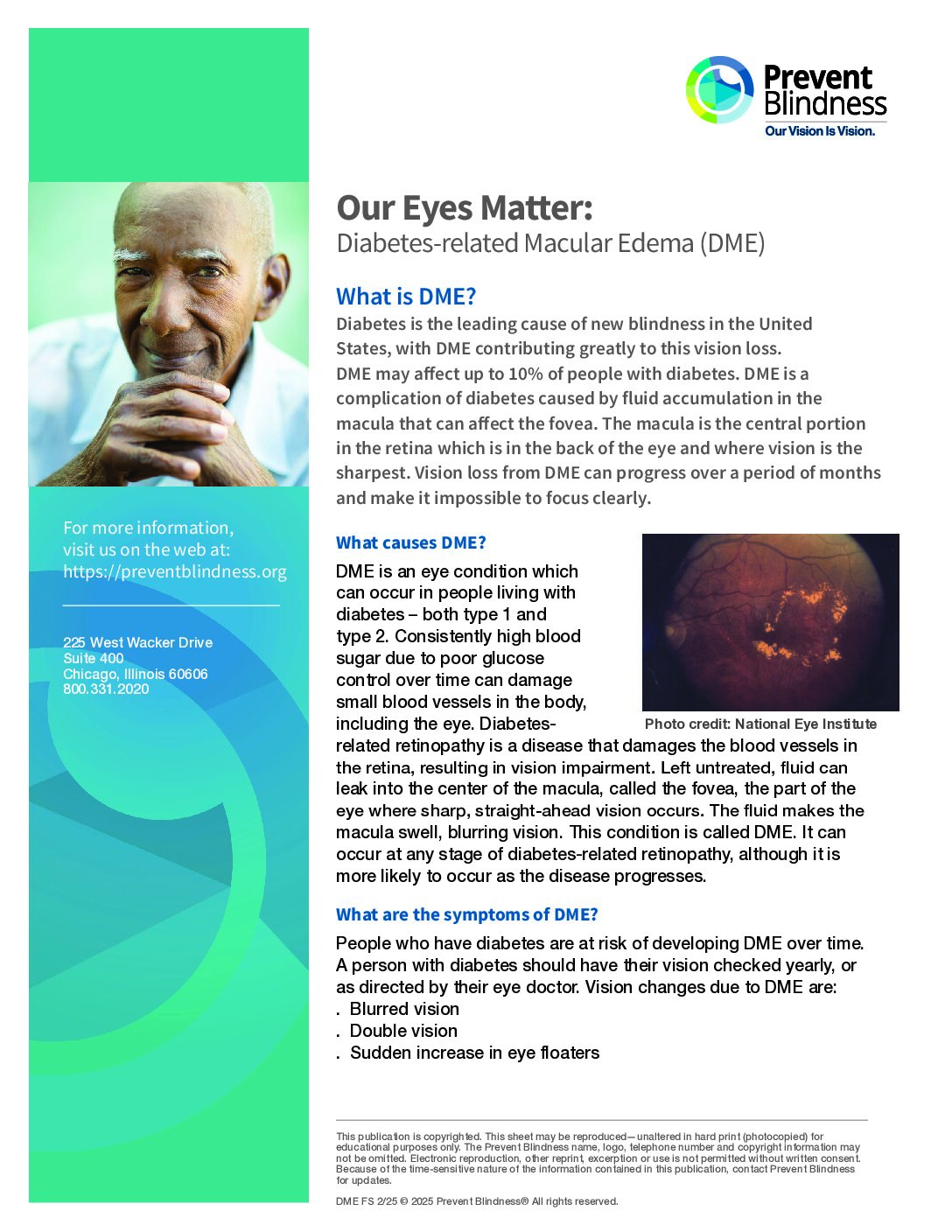What is Diabetic Macular Edema (DME)?
Diabetes is the leading cause of new blindness in the United States, with DME contributing greatly to this vision loss. DME may affect up to 10% of people with diabetes. DME is a complication of diabetes caused by fluid accumulation in the macula that can affect the fovea. The macula is the central portion in the retina which is in the back of the eye and where vision is the sharpest.Vision loss from DME can progress over a period of months and make it impossible to focus clearly.
What Causes DME?
DME is an eye condition which can occur in people living with diabetes – both type 1 and type 2. Consistently high blood sugar due to poor glucose control over time can damage small blood vessels in the body, including the eye. Diabetic retinopathy is a disease that damages the blood vessels in the retina, resulting in vision impairment. Left untreated, fluid can leak into the center of the macula, called the fovea, the part of the eye where sharp, straight-ahead vision occurs. The fluid makes the macula swell, blurring vision. This condition is called DME. It can occur at any stage of diabetic retinopathy, although it is more likely to occur as the disease progresses.
What Are the Symptoms of DME?
People who have diabetes are at risk of developing DME over time. A person with diabetes should have their vision checked yearly, or as directed by their eye doctor. Vision changes due to DME are:
- Blurred vision
- Double vision
- Sudden increase in eye floaters
What Increases Risk for DME?
Increased risk of DME is associated with:
- Poor glucose control over a long period of time
- Increased length of time living with diabetes- The lifetime risk of developing DME for people with diabetes is about 10%.
- Type of diabetes – After living with diabetes for 20 years, nearly all with type 1 and 60% with type 2 diabetes will have some diabetic retinopathy. It usually does not affect vision in the early stages.
- Very high blood pressure
- Fluid retention
- Kidney disease
- High fat levels in the blood (hyperlipidemia)
- Pregnancy – Women who develop diabetes during pregnancy are at risk for diabetic retinopathy and DME.
Download, Print, and Share
the DME Fact Sheet
Diabetes Resources at Prevent Blindness
These resources are designed to support individuals living with diabetes and help them gain access to eye care that they require to maintain healthy vision.
How to Prevent DME
- Maintaining good blood sugar, blood pressure, and cholesterol control helps prevent DME.
- Receiving a comprehensive dilated eye exam at least once a year, or more often as directed by the eye doctor.
- Pregnant woman with diabetes should have a comprehensive dilated eye exam as soon as possible. The eye doctor may recommend additional exams during pregnancy.
- Maintaining a healthy lifestyle, exercising regularly, and having a healthy diet. Talk to a doctor before starting an exercise program.
How is DME Treated?
As with all complications of diabetes, successful management of macular edema requires good control of the diabetes itself. Each of these treatments has their own benefits and risks. Consultation and discussion with the eye doctor is needed to determine the best treatment for an individual’s situation.
Anti-vascular endothelial growth factor (anti-VEGF) drugs and bispecific monoclonal antibody drugs
These drugs block the development of new blood vessels and limit the leakage from the abnormal blood vessels in the eye. They are delivered through an injection into the eye, or an implant to the eye, administered by an ophthalmologist, usually a retinal specialist. While some pressure will be felt during the injection, the eye is first numbed to minimize any discomfort. Several injections over time are needed in this treatment (frequency of injections varied based on the drug selected and the eye doctor’s judgment).
Focal Laser
Laser light is used to close and destroy leaking blood vessels. This form of laser therapy does not typically cause pain. The treatment may leave permanent blind spots in a person’s vision. But it also helps to slow or stop the growth of new blood vessels that could damage vision even more. It helps protect the vision that remains and may slightly improve vision.
Corticosteroids
This treatment involves an injection of steroids into the eye or an injectable steroid eye implant to release the drug over time to decrease DME and improve vision.




